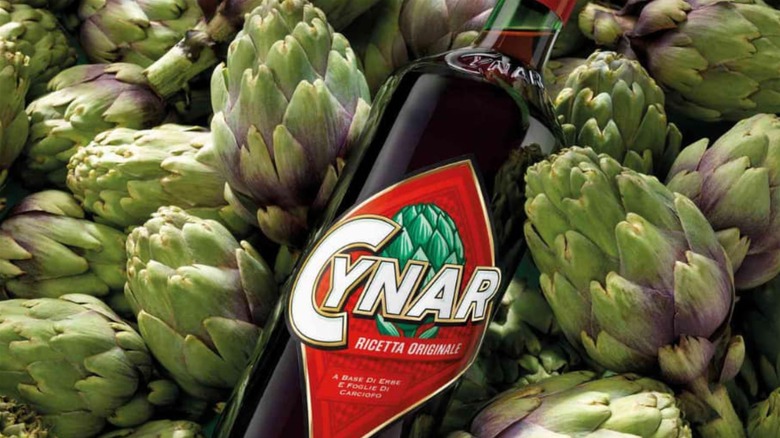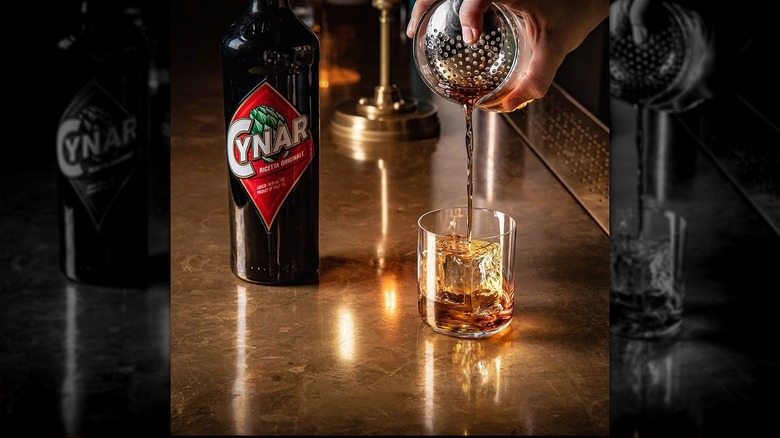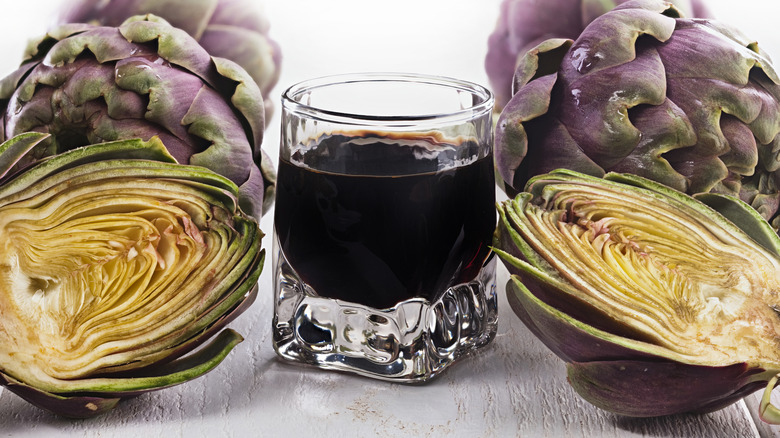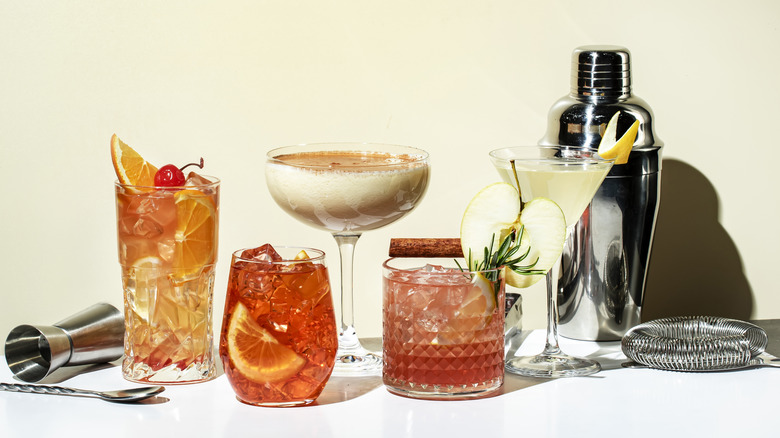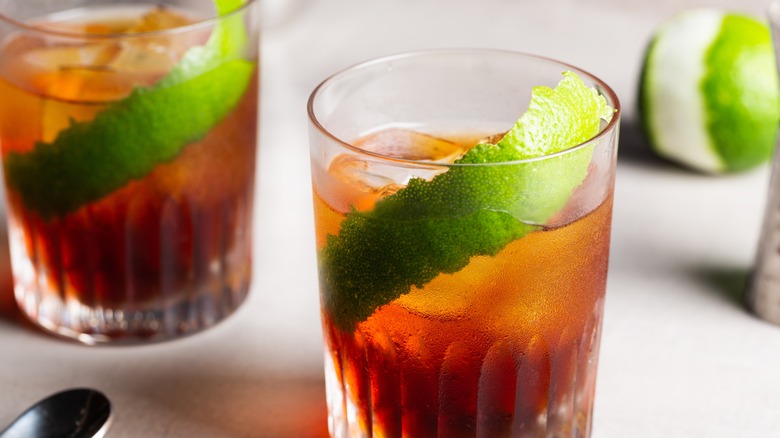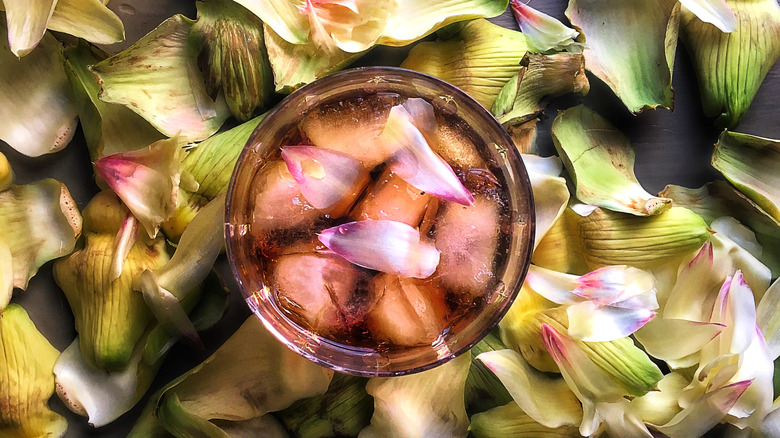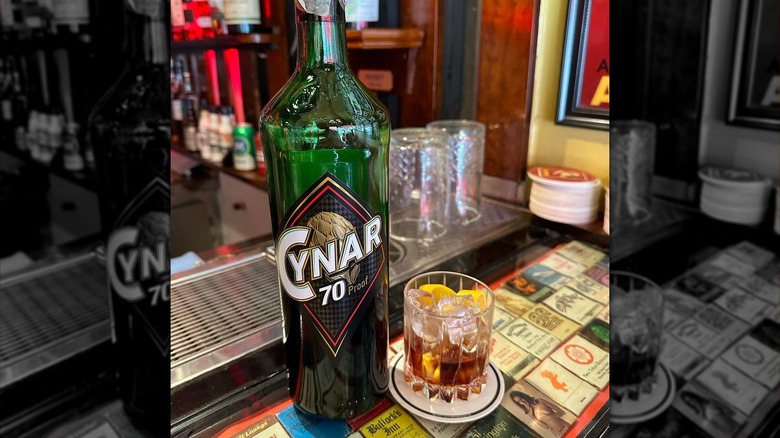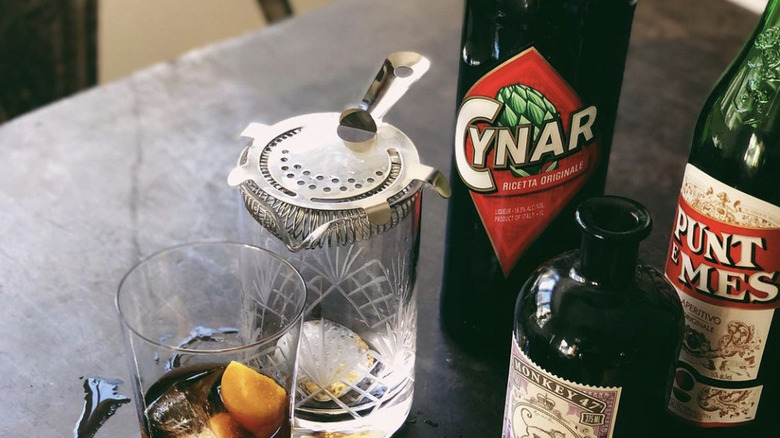What Is Cynar And How Do You Drink It?
The last thing you may expect to see on a sleek and sophisticated bottle of alcohol is a picture of a big, green artichoke. However, one Italian amaro claims the vegetable as its mascot and signature ingredient. Cynar is an Italian amaro made with artichokes and a special recipe of herbs that is the unsung hero of the amari shelf. The bitter liqueur is often used in spritzes and aperitif cocktails, speaking to the innate versatility and unsuspecting flavor of this drink.
We spoke with Lexi Parker, the lead bartender at Poka Lola Social Club in Denver, Colorado, who is a big fan of Cynar. With Parker's guidance and the recommendations of other bartending publications, we curated all you need to know about Cynar and how to drink it. From specialty cocktail recipes to a history lesson in amari, this guide will encourage you to explore the world of this fascinating artichoke liqueur.
What is Cynar?
Cynar, pronounced "chee-NAR," is an amaro (a neutral spirit infused with herbs and botanicals) and derives its name from cynarin an acidic and natural antioxidant found in artichokes. This is not only the liqueur's most distinct ingredient but it is also said to aid in digestion by helping to form a more fluid bile in the stomach, (per Cynara). It is also thought to protect the liver and help with the regeneration of liver cells.
Cynar was released to markets in 1952 by Angelo Dalle Molle, a Venetian entrepreneur who started incorporating artichokes into liqueurs which then spread through Europe. A marketing campaign in the 1960s featuring Italian movie stars Ferruccio De Ceresa and Ernesto Calindri brought Cynar to larger audiences. The Campari Group acquired Cynar in 1995 and has produced the liqueur ever since.
There are hundreds of amari across the world and they are typically served before or after a meal. The former is called an aperitif, used to stimulate the appetite and the latter, called a digestif, is used to help with digestion. With cynarin being an active digestive ingredient in Cynar, it is more often served after the meal.
How Is Cynar Made?
Some experts believe that the process of making Cynar dates back to the Roman empire when amari-makers would boil the less desired parts of the artichoke with water or wine. But, the recipe and process used to make Cynar since its commercialization in 1952, is a secret guarded by the Campari Group. We do know that 13 herbs and plants (botanicals), including artichoke leaves, are infused into Cynar to craft its signature taste.
The infusion process occurs in two stages. First, the herbs and botanicals are percolated and infused with water and alcohol. Percolating the liquid mixture through the herbs will cause it to adopt the flavors and combine them nicely. The mixture is filtered and rests for one month to enhance the liqueur's flavor profile. In the second step, water, sugar, and caramel are mixed with the Cynar extract before it is balanced, bottled, and ready to drink. Despite the recipes for Cynar being proprietary, some dedicated fans will attempt copycat recipes. Sleuths on Reddit say that "fennel, angelica, ginger, and various bittering herbs" are used frequently in at-home Cynar replicas.
Cynar vs. Campari and Aperol
Campari, Aperol, and Cynar are frequently compared and are often substituted for one another. They all have a similar smooth texture and bittersweet qualities.
Campari was invented in 1860 and is owned by the Campari Group, who keep the recipe for this bittersweet, floral red liqueur a secret. It has notes of orange peel and cinnamon, which makes it warmer than Cynar. Campari is also an aperitif and is regularly served in pre-dinner cocktails. It's a signature ingredient in cocktails like Negronis and Boulevardiers. Campari may be a valid substitute, but it is slightly more bitter than Cynar. The alcohol by volume of Campari is 28%, making it a stronger pour than Cynar, which is 16.5% (ABV).
Aperol is another member of the amaro family and has been essential in popular drinks like Aperol spritz and Paper Planes cocktail since its release in 1919. Aperol has a distinct bright orange hue and gets its flavors from orange, rhubarb, and cinchona (tree bark) and, contrary to Campari, is sweeter and brighter than Cynar. When you substitute Aperol for Cynar you may want to balance out the added sweetness with a dash of bitters. The ABV of Aperol is 11%, which is a little lower than Cynar. Other amari like Nonino and Montenegro are much sweeter than Cynar and wouldn't substitute as well as Campari and Aperol.
What Does Cynar Taste Like?
Cynar is a unique liqueur with a complicated flavor. It is slightly sweet and herbaceous, with a bitter aftertaste. As artichokes are an essential ingredient, many assume that Cynar will taste like a vegetable. But, the subtle artichoke properties only give the amaro a slightly vegetal and earthy layer which compliments its caramel, and toffee notes. These flavors combine into an easy-to-drink and approachable liqueur that enhances but rarely overpowers a cocktail. The texture of Cynar is smooth but not as syrupy as other amari.
Expert bartender Lexi Parker explains, "Amari, in general, are little more complex flavor profiles to add into cocktails [and so] a novice bartender might be less likely to consider using them." Parker adds that given has "herbal and vegetal notes, I'm likely to reach for it when looking to incorporate those flavors into a cocktail," adding finally that it, "has a thicker consistency that's helpful when trying to add body to a cocktail."
Cynar has a more subtle flavor than other amari, making it the perfect addition to dealer's choice cocktails, which, according to Parker, are spirit-forward, and stirred cocktails. Parker highlights the Backward's Point, for example, which is a cocktail containing scotch, Cynar, and sweet vermouth. This drink pairs the smokiness of scotch and the herby nature of Cynar into a delicious drink that also smells incredible.
The best cocktails to make with Cynar
Cynar is the star of plenty of cocktail recipes and adds its signature vegetal, herbaceous, and fresh flavor to each of them. Lexi Parker explains, "Agave spirits (mezcal in particular) are very prone to vegetal and citrus notes which go great with Cynar, and bourbon/rye stirred cocktails tend to lend themselves well to the herbaceous nature of Cynar."
Parker recommends using Cynar in a Florentine cocktail, which combines equal parts Cynar, vermouth, and Cocchi Americano. The quinine-forward Cocchi Americano and Cynar blend perfectly with the vermouth to make a smooth sipper. Parker also notes her favorite Cynar cocktail: the Filthy Rich. She explains it's her top choice "because of its utilization of not only Cynar but rye whiskey [...] as well as Benedictine, which is another one of my favorite herbaceous and weighty liqueurs," it's her clear favorite. The drink contains equal parts rye whisky and vermouth, with Cynar and Benedictine stirred with ice.
Cynar is fabulous in slow-sipping drinks but also lends itself to the lighter, bubbly, aperitif tradition. The Aperol spritz is one of the more popular amaro aperitifs. But, swapping out the Aperol for Cynar is ideal for those wanting to pair down the sweetness and embrace a more bittersweet drink. A Cynar spritz contains Prosecco, club soda, a lemon or olive garnish (and of course Cynar).
Where to buy Cynar
Most liquor stores that keep amari on shelves will carry Cynar. However, smaller or limited-stock liquor stores could be hit-or-miss. A 700-milliliter bottle of Cynar will cost around $20. The same-sized bottle of Cynar 70 (which is 70 proof) will cost a little more and typically lands in the $40-$50 range. When roaming the aisles of a liquor store for Cynar, first navigate to the liqueurs and cordials section, which will likely have the amaro you're looking for. Cynar bottles always have the signature artichoke design, making them hard to miss.
Not all bars will carry Cynar. However, this liqueur is popular in its home nation, Italy, and is also a mainstay in Argentina and Brazil. American bars may have Cynar, but Lexi Parker noted that not all bartenders will "reach for Cynar without a particular recipe in mind or until they have a better understanding of how to build cocktails."
Nutritional Information About Cynar
Cynar is labeled as an aperitif and digestif, which indicates specific properties. Aperitif is a term used to describe dry or bubbly alcoholic drinks with a low ABV served before a large dinner. The word comes from "aperitivo", which means "appetizer" in Italian. Spritzes and bubbly wine with herbal notes are served before a meal to stimulate the appetite, though there is little modern evidence to support that tradition. A Cynar spritz is the perfect light, refreshing aperitif.
Digestifs are the opposite of aperitifs. They are served after a large meal to settle the stomach and aid digestion. They often have a higher ABV than aperitifs and can be sweet, like dessert. Amari are ideal digestifs because the herbaceous and botanical ingredients are believed to help calm the stomach after a big dinner. It's typical to drink digestifs neat and at room temperature.
Other notable nutritional information includes 193 calories, 26 grams of carbohydrates (which is all sugar), and zero grams of protein and fat in a 100-milliliter serving. The exact ingredient list is kept secret by the Campari Group, but at least we know it contains artichokes. With an ABV at 16.5%, it's a relatively moderate drink compared to other amari, liqueurs, and hard alcohols.
Varieties of Cynar
2015 was an excellent year for Cynar fans because the Campari Group released Cynar 70, a higher-proof alternative to the original. Cynar 70 has a 35% ABV, which compared to the 16% ABV in the standard bottle, packs quote a punch. Cynar 70 is a bit darker in color compared to the standard bottle, but the taste is relatively similar. Both varieties are crafted with the signature 13 herbs, including artichokes. They also share the caramel and woody flavors distinct from the brand. In this way, Cynar 70 isn't much different from its predecessor but is a better fit for drinkers who prefer a more robust pour.
Cynar and Cynar 70 are suitable for endless cocktail recipes, but a few drinks pair better with the stronger-proof liqueur. Reddit users in the amaro group recommended using Cynar 70 in drinks like a Black Manhattan that contains rye whiskey, amaro (in this case, Cynar 70), bitters, and cherry. To balance out the added bitterness you may want to add a little extra splash of cherry syrup. Another Reddit user recommended using Cynar 70 in a Too Soon Sour cocktail with gin, Cynar 70, lemon, simple syrup, and an orange garnish.
How to store Cynar
Cynar is an easy liqueur to keep around. Both the original Cynar and Cynar 70 can be stored in a cool, dry place like a cupboard or pantry. Keeping the liqueur at room temperature will not damage the liqueur quickly but may change the flavors over time. A rule of thumb for storing liqueur is that wine-based spirits should be refrigerated to prevent the breakdown of flavors. But, Cynar is made of a neutral spirit, so it may not be essential to refrigerate it, however, you may want to store an open bottle of Cynar in the fridge to maintain fresh flavors and prevent oxidation. This tactic also ensures a cool, refreshing pour. In any storage location. this amaro should be stored upright and tightly sealed.
Liqueurs in the amari family tend to taste the freshest for 2 to 4 months after being opened. Their shelf life can extend from 6 months to a year, but it's a good idea to regularly taste them to ensure the flavors remain intact.
Methodology
Cynar is a complicated liqueur; only some people are familiar with using it in cocktails. To craft this guide, we scoured sites on the internet like bartending blogs, online forums, alcohol producers, vendors, and bartending publications. We also consulted expert bartender Lexi Parker, who informed us about Cynar cocktails and flavor profiles. This extensive guide should give any beginner a fundamental understanding of the artichoke amaro.
